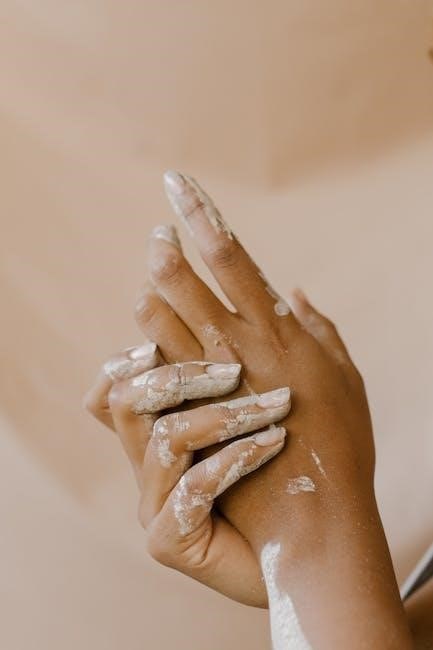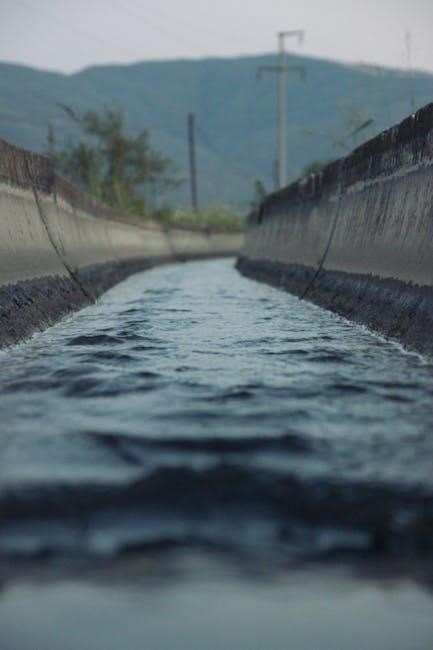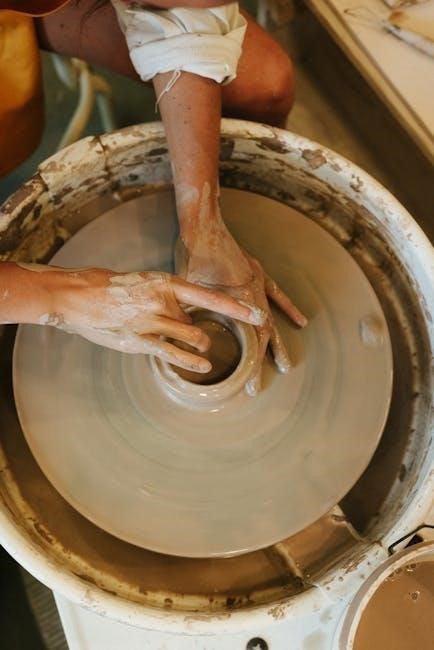Manual Lymphatic Drainage (MLD) is a specialized massage technique that promotes lymph fluid circulation, aiding in detoxification and reducing swelling. Developed by European therapists, it is widely recognized for its therapeutic benefits and is increasingly popular in wellness centers and medical spas. MLD courses train practitioners to perform gentle, rhythmic strokes, enhancing lymph flow and supporting overall well-being.
1.1 What is Manual Lymphatic Drainage?
Manual Lymphatic Drainage (MLD) is a gentle, specialized massage technique that stimulates the lymphatic system to promote the removal of lymph fluid. It involves light, rhythmic strokes that stretch the skin, enhancing the flow of lymph through vessels and nodes. This therapy aids in reducing swelling, detoxifying the body, and improving circulation. Commonly used for conditions like lymphedema and post-surgical recovery, MLD is also valued for its relaxing and rejuvenating effects, making it a popular treatment in both medical and wellness settings.
1.2 History and Development of MLD
Manual Lymphatic Drainage (MLD) originated in Europe in the 1930s, developed by Dr. Emil Vodder, a Danish therapist. Initially used for treating chronic sinusitis and other lymphatic disorders, MLD gained recognition for its effectiveness in reducing swelling and enhancing lymph circulation. Over time, it evolved into a cornerstone of lymphedema management and post-surgical recovery. Today, MLD is widely practiced globally, with courses offering both traditional techniques and modern adaptations, ensuring its continued relevance in therapeutic and wellness settings.
Benefits of Manual Lymphatic Drainage
MLD enhances lymph circulation, reduces swelling, and detoxifies the body. It eases post-surgical recovery, alleviates lipedema symptoms, and promotes deep relaxation, improving overall well-being.
2.1 Physical Benefits of MLD
Manual Lymphatic Drainage (MLD) offers numerous physical benefits, including reduced swelling and improved circulation. It aids in post-surgical recovery, enhances wound healing, and alleviates conditions like lipedema and lymphedema. MLD promotes the removal of toxins by stimulating lymph flow, which strengthens the immune system. Regular sessions can also reduce muscle tension and pain, while improving overall tissue health. These benefits make MLD a valuable therapy for those seeking to enhance physical well-being and manage chronic conditions effectively.
2.2 Emotional and Relaxation Benefits
Manual Lymphatic Drainage (MLD) provides profound emotional and relaxation benefits. The gentle, rhythmic strokes create a calming effect, reducing stress and anxiety. MLD promotes deep relaxation, enhancing mental well-being and improving sleep quality. Many clients experience a sense of tranquility during sessions, as the technique fosters a connection between body and mind. Its soothing nature makes it a popular choice in med spas and wellness centers, offering emotional relief alongside physical benefits. This holistic approach to health underscores its growing popularity as a therapeutic practice.
Techniques and Methods in MLD
MLD involves gentle, light, and precise manual techniques to stimulate lymph nodes and vessels, promoting fluid circulation. These methods are taught in specialized courses for practitioners.
3.1 Basic Techniques of Manual Lymphatic Drainage
Manual Lymphatic Drainage (MLD) employs gentle, light, and precise strokes to stimulate lymph nodes and vessels, encouraging the flow of lymph fluid. Techniques include circular motions, spirals, and stretching of the skin to redirect fluid away from swollen areas. The pressure applied is minimal, ensuring comfort and effectiveness. These methods are designed to enhance circulation, reduce swelling, and promote detoxification. Proper training is essential to master these techniques, as they require a deep understanding of lymphatic anatomy and physiology. MLD courses teach practitioners to perform these strokes accurately and safely.
3.2 Advanced Techniques for Specialized Conditions
Advanced techniques in Manual Lymphatic Drainage (MLD) address complex conditions like lymphedema, lipedema, and chronic swelling. These methods include deep lymph node stimulation, multi-directional stretching, and targeted pressure points to enhance fluid mobilization. Practitioners learn to adapt techniques for post-surgical recovery, scar tissue management, and specific client needs. These specialized approaches require advanced training and are often covered in comprehensive MLD courses, ensuring safe and effective treatment for diverse conditions.
Who Can Perform Manual Lymphatic Drainage?
Licensed therapists, including massage therapists and physical therapists, can perform MLD after specialized training. Certification is essential to ensure safe and effective treatment.
4.1 Licensed Practitioners and Therapists
Manual Lymphatic Drainage is typically performed by licensed practitioners, including massage therapists, physical therapists, and medical professionals. These individuals undergo specialized training to master the gentle, rhythmic strokes required for effective lymphatic drainage. Certification ensures they understand the anatomy and physiology of the lymphatic system, enabling safe and beneficial treatments. Practitioners work in various settings, such as spas, clinics, and hospitals, providing relief for conditions like lymphedema and post-surgical swelling. Their expertise is crucial for achieving optimal results and minimizing risks associated with improper technique.
4.2 Training and Certification Requirements
Training for Manual Lymphatic Drainage typically involves specialized courses that combine theoretical and practical instruction. Programs vary in duration, from a few days to a week, and cover lymphatic system anatomy, physiology, and drainage techniques. Certification often requires completing coursework, passing a written or practical exam, and demonstrating competence in performing MLD. Many courses are accredited by professional organizations, ensuring high standards of education. Practitioners must also commit to continuing education to maintain certification and stay updated on industry advancements.
Manual Lymphatic Drainage Courses Overview
MLD courses teach gentle, rhythmic techniques to enhance lymph flow, reduce swelling, and promote relaxation. They cover theory, practical skills, and applications in wellness and therapy.
5.1 What to Expect in a Typical MLD Course
A typical MLD course combines theoretical foundations with hands-on training. Students learn the anatomy of the lymphatic system, contraindications, and techniques for various conditions. Practical sessions focus on mastering strokes, pressure, and rhythm. Courses often include case studies and demonstrations, emphasizing proper application in clinical and spa settings. Many programs offer certification upon completion, providing practitioners with the skills to address swelling, promote relaxation, and support recovery in diverse client populations, from post-surgery patients to those with lymphedema or lipedema.
5.2 Online vs. In-Person Training Options
MLD courses are available in both online and in-person formats, catering to different learning preferences. Online courses offer flexibility, allowing students to learn at their own pace, while in-person training provides hands-on experience and direct instructor feedback. Both formats typically cover similar content, including theoretical knowledge and practical techniques. Online options often include video demonstrations and interactive modules, while in-person classes emphasize live practice and real-time corrections. Accreditation and certification are available for both, ensuring competency regardless of the chosen format.

Applications of Manual Lymphatic Drainage
MLD is widely used for pre- and post-operative care, reducing swelling and promoting healing. It is also applied in managing lipedema and lymphedema, enhancing overall well-being.
6.1 MLD for Pre- and Post-Operative Surgery
Manual Lymphatic Drainage (MLD) is commonly used in surgical care to enhance recovery. Pre-operatively, it reduces inflammation and improves lymph flow, preparing the body for surgery. Post-operatively, MLD minimizes swelling, accelerates healing, and supports the removal of excess fluids. Gentle, rhythmic strokes promote circulation and tissue repair, reducing the risk of complications. This specialized massage is particularly beneficial for patients undergoing cosmetic or reconstructive surgeries, helping them achieve smoother, faster recovery outcomes. Its application is tailored to individual needs, making it a valuable tool in surgical aftercare.
6.2 MLD for Lipedema and Lymphedema Management
Manual Lymphatic Drainage (MLD) is a cornerstone in managing lipedema and lymphedema, conditions characterized by abnormal fat distribution and lymphatic system dysfunction. MLD helps reduce swelling by enhancing lymph fluid circulation and promoting its drainage. For lipedema, MLD alleviates discomfort and improves tissue health. In lymphedema, it is a key component of Complete Decongestive Therapy (CDT), aiding in long-term limb volume reduction. Practitioners trained in MLD courses learn specialized techniques to address these conditions, offering patients a non-invasive and effective approach to manage symptoms and improve quality of life.

Choosing the Right MLD Course
Choosing the right MLD course involves considering accreditation, instructor expertise, hands-on training, and curriculum comprehensiveness. Ensure the program offers both theoretical knowledge and practical skills, focusing on effective lymphedema and lipedema management techniques.
7.1 Key Factors to Consider
When selecting an MLD course, prioritize accreditation and reputation to ensure quality training. Look for experienced instructors with expertise in lymphatic therapy. Ensure the curriculum includes both theoretical and practical components, focusing on techniques for various conditions like lymphedema and lipedema. Consider the availability of hands-on training and opportunities for real-world application. Additionally, review course reviews and alumni feedback to gauge program effectiveness. Lastly, check if the course offers certification and ongoing support for professional development.
7.2 Accreditation and Reputation of Institutions
Ensure the institution offering the MLD course is accredited by a recognized professional body, guaranteeing adherence to industry standards. Research the institution’s reputation by reading reviews and testimonials from past students. A reputable institution will have experienced instructors with expertise in lymphatic therapy. Additionally, verify that the curriculum is evidence-based and comprehensive, covering both theoretical and practical aspects of MLD. Accredited institutions often provide certification, enhancing your credibility as a practitioner and opening doors to professional opportunities.

Career Opportunities in MLD
MLD certification opens doors to roles in spas, clinics, hospitals, and private practices. Growing demand in wellness and post-surgery care expands opportunities for skilled practitioners.
8.1 Job Roles and Specializations
Professionals certified in MLD can pursue diverse roles, including lymphedema therapist, spa practitioner, or private clinician. Specializations may focus on post-surgical recovery, oncology care, or aesthetic wellness. Many work in medical settings, spas, or private practices, offering tailored treatments. Some also integrate MLD into holistic wellness programs or med spas, addressing client needs for relaxation and detoxification. With growing demand, certified MLD specialists are sought after for their expertise in promoting lymphatic health and enhancing overall well-being.
8.2 Salary Expectations and Industry Demand
Salaries for MLD professionals vary based on experience and setting, ranging from $40,000 to over $70,000 annually. Demand is rising, driven by the growing popularity of med spas and wellness centers. Certified therapists in specialized fields like lymphedema management or post-surgical care often earn higher rates. As awareness of lymphatic health increases, job opportunities expand, making MLD a promising career path with strong growth potential and competitive compensation.

Future Trends in Manual Lymphatic Drainage
MLD is evolving with innovative techniques and technologies, enhancing efficacy. Online courses are expanding accessibility, while specialized training in areas like post-surgery and lipedema is growing, meeting increasing demand in med spas and wellness centers, ensuring high standards and quality in the profession.
9.1 Advances in MLD Techniques and Technology
Advances in MLD techniques and technology are enhancing treatment efficacy and accessibility. Innovative tools and methodologies, such as digital mapping of lymphatic pathways, are improving precision. Online platforms now offer specialized training, enabling therapists to refine their skills remotely. Additionally, the integration of MLD with other therapies, like laser therapy, is expanding its applications. These developments are raising the bar for practitioners, ensuring higher standards and more effective outcomes in lymphatic care.
9.2 Growing Popularity in Med Spas and Wellness Centers
Manual Lymphatic Drainage is gaining prominence in med spas and wellness centers due to its holistic benefits and luxurious appeal. Clients seek MLD for detoxification, relaxation, and post-operative recovery, particularly in cosmetic procedures. Its inclusion in high-end spas highlights its demand as a premium service. Training programs are adapting to this trend, offering specialized certifications to meet the growing need for skilled therapists in these settings. This shift underscores MLD’s evolution from a niche therapy to a mainstream wellness staple.